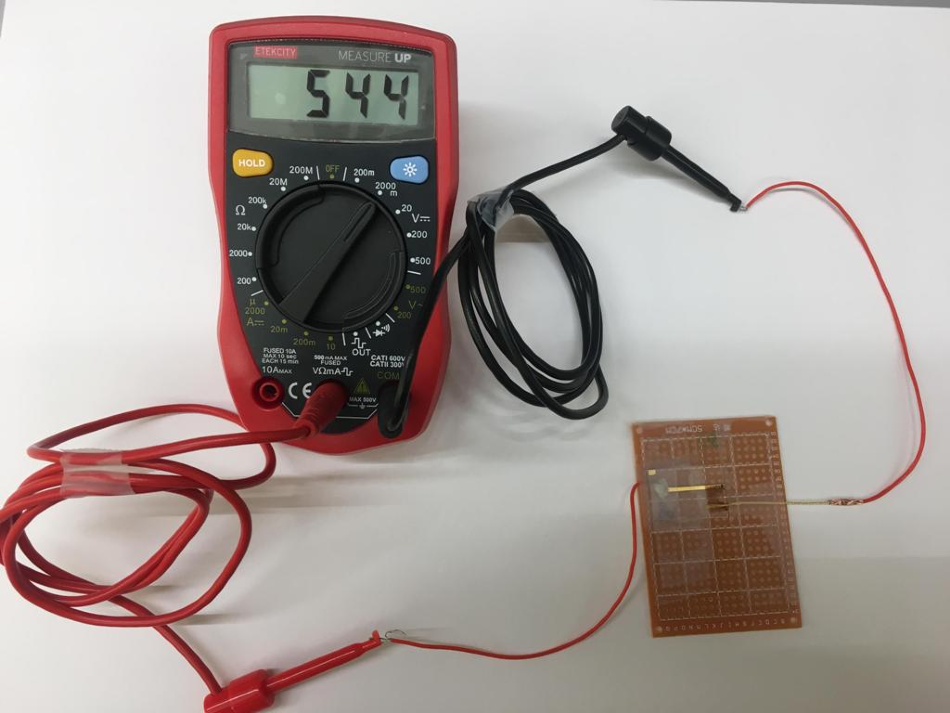Feb 18 2020
At the University of Massachusetts Amherst (UMass Amherst), researchers have created a device that utilizes a natural protein to generate electrical current from moisture present in the atmosphere.
 The current Air-gen device can power small devices. Image Credit: UMass Amherst/Yao and Lovley labs.
The current Air-gen device can power small devices. Image Credit: UMass Amherst/Yao and Lovley labs.
According to the team, this latest technology holds important implications in the future of medicine and for the future of climate change and renewable energy.
At UMass Amherst, the laboratories of electrical engineer Jun Yao and microbiologist Derek Lovley have developed a new device, which the researchers dubbed air-powered generator, or “Air-gen,” using electrically conductive protein nanowires created by the Geobacter microorganism. The study was recently published in the Nature journal.
This Air-gen links electrodes to the protein nanowires such that electricity is produced from the water vapor that occurs naturally in the air.
We are literally making electricity out of thin air. The Air-gen generates clean energy 24/7.
Jun Yao, Electrical Engineer, Department of Electrical and Computer Engineering, The University of Massachusetts Amherst
Lovely, who has improved sustainable biology-based electronic materials for more than 30 years, stated, “It’s the most amazing and exciting application of protein nanowires yet.”
Developed in Yao’s laboratory, the new technology is renewable, non-polluting, and economical. It can produce electricity even in very low humidity areas like the Sahara Desert.
According to Lovley, the technology has considerable benefits when compared to other forms of renewable energy, including wind and solar energy. This is because the Air-gen device does not need wind or sunlight, and “it even works indoors,” unlike other forms of renewable energy sources.
The team explained that the Air-gen device needs just a thin film of protein nanowires with a thickness of less than 10 μm. While the base of the film sits on an electrode, a smaller electrode covering just a part of the nanowire film rests on top.
The thin film adsorbs atmospheric water vapor. A combined setup, which includes the surface chemistry of the protein nanowires, electrical conductivity, and the fine pores that exist between the nanowires inside the film, defines the conditions that produce electricity between the pair of electrodes.
According to the scientists, present-day Air-gen devices are capable of powering tiny electronics, and they hope to scale up this invention to commercial scale in the near future.
The researchers are now planning to develop a tiny Air-gen “patch” that can drive electronic wearables, like smartwatches and health and fitness monitors, which would avoid the need for standard batteries. The team is also hoping to create Air-gens that can be used in cellular phones to prevent periodic charging.
The ultimate goal is to make large-scale systems. For example, the technology might be incorporated into wall paint that could help power your home. Or, we may develop stand-alone air-powered generators that supply electricity off the grid.
Jun Yao, Electrical Engineer, Department of Electrical and Computer Engineering, The University of Massachusetts Amherst
Yao continued, “Once we get to an industrial scale for wire production, I fully expect that we can make large systems that will make a major contribution to sustainable energy production.”
To further improve the practical biological capabilities of Geobacter, Lovley’s laboratory has recently created a novel microbial strain to produce protein nanowires more quickly, cost-effectively, and at a massive scale.
We turned E. coli into a protein nanowire factory. With this new scalable process, protein nanowire supply will no longer be a bottleneck to developing these applications.
Derek Lovley, Microbiologist, Microbiology Department, The University of Massachusetts Amherst
The discovery of Air-gen discovery reflects extraordinary interdisciplinary teamwork, stated the research team. The Geobacter microbe was discovered by Lovley over three decades ago. He detected this microorganism in the mud of the Potomac River.
Lovley’s laboratory later identified the microbe’s potential to create electrically conductive protein nanowires. Prior to joining UMass Amherst, Yao had worked at Harvard University for many years and designed electronic devices using silicon nanowires. Lovley and Yao teamed up to see if handy electronic devices could be developed with the protein nanowires extracted from the Geobacter microbe.
Xiaomeng Liu, a Ph.D. student in Yao’s laboratory, was creating sensor devices when he came across an unusual thing.
He recalled, “I saw that when the nanowires were contacted with electrodes in a specific way the devices generated a current. I found that that exposure to atmospheric humidity was essential and that protein nanowires adsorbed water, producing a voltage gradient across the device.”
Apart from the Air-gen, Yao’s laboratory has created many other applications using the protein nanowires. “This is just the beginning of new era of protein-based electronic devices” Yao added.
The study was partly financed from a seed fund via the Office of Technology Commercialization and Ventures at UMass Amherst and research development funds from the campus’s College of Natural Sciences.